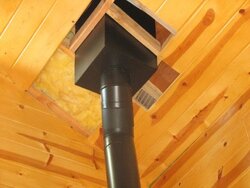Once again I'm asking for some advice. This time on a chiney. I plan on installing a cast or soap stone free standing stove in my place. Min. chimney height to be code compliant will need to be +,- 21 feet, from the top of the stove.
I realize that running the chimney from the top of the stove straight up through the ceiling and roof would be the ideal install. If I do it that way, there would be about 11 LF of chimney inside, and 8-9 feet after it pops through the roof. The room where the stove will go has a vaulted ceiling. Problem might arise with the location of the roof rafters/ceiling joists in relation to the chimney. I might need to use a couple of 45s to get around a rafter and I'd rather not do that. I could cut the rafter and reenforce it with cross members. I was a carpenter by trade for 25 years, prior to back surgery ( but don't wanna get into more of a project if I don't have to.
( but don't wanna get into more of a project if I don't have to.
SOooooo, I'm wondering if the chiney would draft ok if I ran it up the out side. ie stove pipe 3-4 up from the stove top, then 90 to the ouside, then a "T", and up about 16 feet with insulated double wall. I'd probably build a chase around the chimney in the spring. And could insulate the chase, if necessary. Another advantage to this method, is it would be easy to pull the cap from the bottom of the T to check the inside of the chimney.
If I go to the outside, would there be sufficient draft ?
Thanks in advance )
)
I realize that running the chimney from the top of the stove straight up through the ceiling and roof would be the ideal install. If I do it that way, there would be about 11 LF of chimney inside, and 8-9 feet after it pops through the roof. The room where the stove will go has a vaulted ceiling. Problem might arise with the location of the roof rafters/ceiling joists in relation to the chimney. I might need to use a couple of 45s to get around a rafter and I'd rather not do that. I could cut the rafter and reenforce it with cross members. I was a carpenter by trade for 25 years, prior to back surgery
 ( but don't wanna get into more of a project if I don't have to.
( but don't wanna get into more of a project if I don't have to.SOooooo, I'm wondering if the chiney would draft ok if I ran it up the out side. ie stove pipe 3-4 up from the stove top, then 90 to the ouside, then a "T", and up about 16 feet with insulated double wall. I'd probably build a chase around the chimney in the spring. And could insulate the chase, if necessary. Another advantage to this method, is it would be easy to pull the cap from the bottom of the T to check the inside of the chimney.
If I go to the outside, would there be sufficient draft ?
Thanks in advance
 )
)


